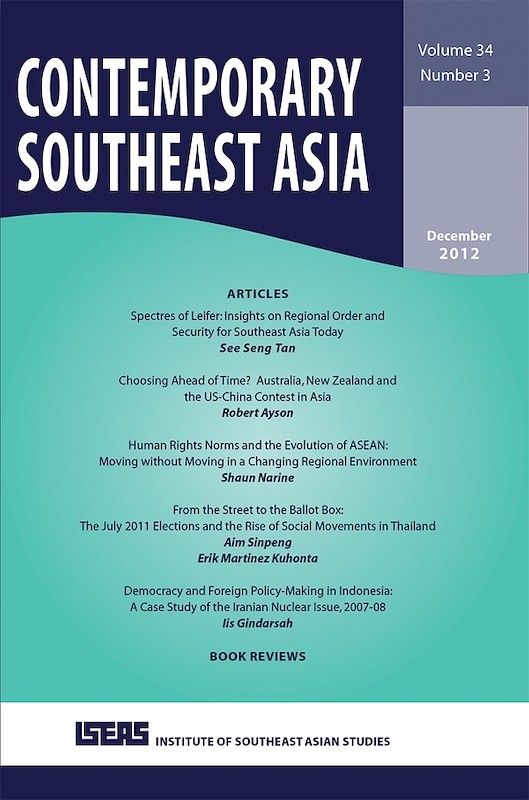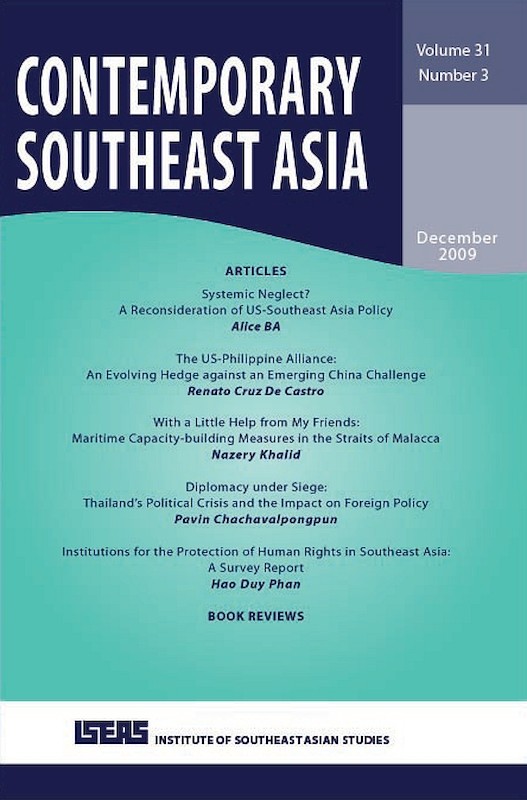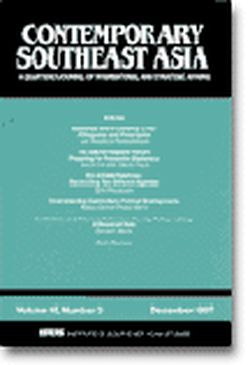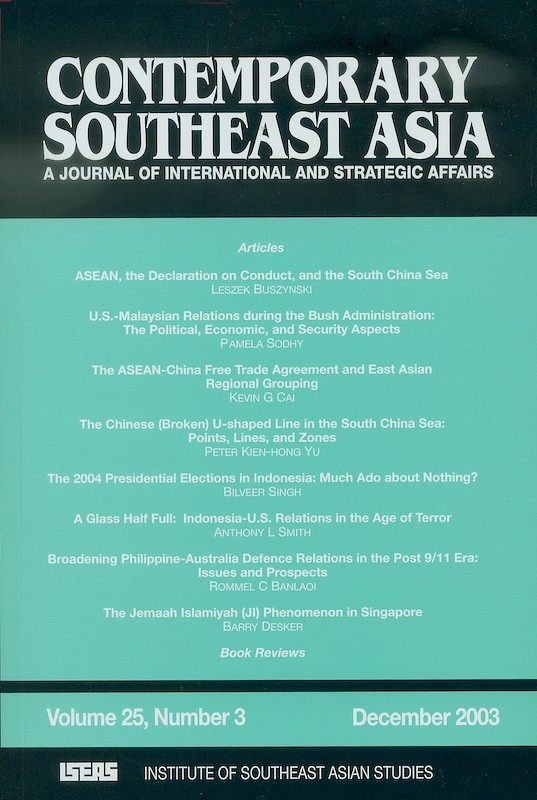Contemporary Southeast Asia Vol. 34/3 (Dec 2012)

Date of publication:
December 2012
Publisher:
Institute of Southeast Asian Studies
Number of pages:
140
Code:
CS34/3
Contents
-
Contemporary Southeast Asia Vol. 34/3 (Dec 2012)
[Whole Publication] -
Preliminary pages
- ARTICLES
-
Spectras of Leifer: Insights on Regional Order and Security for Southeast Asia Today, by See Seng Tan, author see abstractMichael Leifer's passing over a decade ago has done little to diminish the force of his scholarly ideas and their continued relevance to the study of regional order and security of contemporary Southeast Asia. Leifer's intellectual influence is apparent in the way analysts of different theoretical persuasions continue to grapple with and debate over the problem of regional order in Southeast Asia. In so doing, they rely on terms of reference originally defined by Leifer. This article reviews and assesses a number of noteworthy insights from Leifers oeuvre against the contemporary political-strategic situation of Southeast Asia and its immediate extra-regional context. The insights include the elusiveness of regional order, the primacy of the balance of power, and the emphasis on conservation rather than innovation in the management of regional security in Southeast Asia. While Leifers ideas are by no means timeless, they continue nonetheless to speak in telling ways to the security challenges facing Southeast Asia today.
-
Choosing Ahead of Time? Australia, New Zealand and the US-China Contest in Asia, by Robert Ayson, author see abstractAustralia's profile as one of Washington's leading allies in the Asia Pacific has grown due to the Obama Administration's rebalancing strategy. While New Zealand is both unable and unwilling to match the intensity of its neighbour's relationship with the world's leading power, its own strategic ties with Washington have strengthened considerably in recent times. While Australia's alliance with the United States may raise future challenges vis-Ã -vis its increasingly important relationship with a rising China, New Zealand also has a balancing act to maintain, not least because of its close economic ties with the People's Republic. In different ways both Australia and New Zealand may currently be reducing their room for maneouver if and when the contest between the United States and China becomes more severe. The risks may be higher for Australia because the same strategic geography that gives it renewed prominence may also increase its exposure to competition and conflict in Asia, and because its own military rebalancing towards the north and west of the continent is occurring just as its defence budget has been significantly cut. For New Zealand, while those direct risks may be smaller, staying on Canberra's radar screen will become harder. Indeed as they each look towards their own relationships with the major powers, Australia and New Zealand may need to work even harder to sustain their own bilateral alliance relationship.
-
Human Rights Norms and the Evolution of ASEAN: Moving without Moving in a Changing Regional Environment, by Shaun Narine, author see abstractIn recent years, ASEAN has implemented numerous organizational reforms that are designed to rejuvenate its institutional structures and international reputation. Among these reforms has been the introduction of the ASEAN Intergovernmental Commission on Human Rights (AICHR). This body is meant to monitor and promote human rights norms and practices among the ASEAN states. It has been criticized, however, as lacking the power to force state compliance. This paper argues that ASEAN's apparent willingness to entertain a more robust institutional human rights regime is properly understood as part of its effort to rehabilitate the organization's international credibility as opposed to an indication of a substantive normative shift in the outlook of key ASEAN members. The paper examines the circumstances around the creation of the AICHR and considers the ongoing state-building problems faced by most ASEAN states. It argues that the AICHR is the product of an inadequate planning process and that the international human rights environment is changing in ways that will relieve the pressure on ASEAN to reform in a manner that reflects the rhetorical preferences of the Western world on the issue of human rights.
-
From the Street to the Ballot Box: The July 2011 Elections and the Rise of Social Movements in Thailand, by Aim Sinpeng, Erik M Kuhonta, authors see abstractThe July 2011 parliamentary elections in Thailand were significant because they ushered politics away from street demonstrations and into the polling booth. Just about a year after the worst political violence in Bangkok since the 1992 Black May incident, these elections confirmed the dominance of Thaksin Shinawatra-aligned parties and the prominence of social movements in engaging the electoral process. Notable were the Red Shirts who moved from street battle to electoral contestation in supporting Phua Thai and the Yellow Shirts who campaigned against politicians and political parties. No election in Thai history has had such a high degree of social mobilization as that of the 2011 polls.
-
Democracy and Foreign Policy-Making in Indonesia: A Case Study of the Iranian Nuclear Issues, 2007-08, by Iis Gindarsah, author see abstractThis article studies the impact of domestic politics on Indonesia's foreign policy-making. Serving as a non-permanent member of the United Nations Security Council (UNSC) from 2007 to 2008, Indonesia voted on two key resolutions concerning the Iranian nuclear issue. While approving international sanctions against Iran under UNSC Resolution No. 1747, the Indonesian government abstained from voting on Resolution No. 1803 which imposed additional sanctions on Tehran. This article argues that the country's changing response to the Iranian nuclear issue was a consequence of domestic opposition. The case study specifically identifies the Muslim-majority population, religious mass organizations, and political parties, as key factors which weighed upon the "risk calculus" behind Indonesia's foreign policy formulation. The article concludes that while the executive still drives the countrys foreign policy, Indonesias Parliament and social-political groups have gained new powers to influence the government into changing or even reversing existing policies.
- BOOK REVIEWS
-
BOOK REVIEW: Mapping National Anxieties: Thailand's Southern Conflict, by Duncan McCargo, by Joseph Chinyong Liow, author
-
BOOK REVIEW: Burma Redux: Global Justice and the Quest for Political Reform in Myanmar, by Ian Holliday, by Kyaw San Wai, author
-
BOOK REVIEW: Freedom in Entangled Worlds: West Papua and the Architecture of Global Power, by Eben Kirksey, by Budi Hernawan, author






